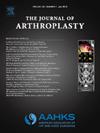Same-Day Discharge Total Knee Arthroplasty: Hospital Demonstrates Similar Outcomes to Ambulatory Surgery Center in a More Complex Patient Population
IF 3.4
2区 医学
Q1 ORTHOPEDICS
引用次数: 0
Abstract
Background
The purpose of this study was to compare outcomes between patients undergoing same-day discharge (SDD) total knee arthroplasty (TKA) at an ambulatory surgery center (ASC) versus a tertiary care university hospital setting.
Methods
A single tertiary academic center’s institutional database was reviewed for patients who underwent primary TKA and were discharged the same day from August 2021 to January 2024. Patients who did not have at least 1 year of follow-up were excluded. Patient demographics, comorbidities, patient-reported outcome measures, emergency department visits, admissions, reoperations, and revisions were collected. Patients were stratified by the location of their surgery: ASC versus hospital. Specific criteria had to be met prior to surgery at the ASC, and the final decision regarding the location of surgery was made via shared decision-making between the patient and their surgeon. Patients who did not meet ASC criteria underwent TKA at the main hospital. Univariable analyses were used to compare groups, and multivariable logistic regression was used to determine if surgical location was a significant factor. Of the 449 TKAs meeting inclusion criteria, 63.3% (284) were performed at the ASC and 36.7% (165) at the university hospital at a mean follow-up of 1.51 years (range, 1.00 to 2.40). Of those 165 whose surgery was done at the hospital, 93.9% met at least one ASC exclusion criteria.
Results
Patients whose TKA was done at the hospital had significantly higher weight (P = 0.003), body mass index (P < 0.001), Elixhauser comorbidity index (P < 0.001), proportion of patients who had an American Society of Anesthesiologists classification of 3 (P = 0.023), and proportion of patients who required general anesthesia (P < 0.001). Additionally, patients whose TKA was done at the hospital had higher preoperative patient-reported outcome measurement information system (PROMIS) pain interference (PI) (62.0 [59.0, 66.0] versus 63.0 [61.8, 67.0]; P = 0.006), and lower physical function (PF) (39.0 [36.0, 43.0] versus 38.0 [34.0, 41.0]; P = 0.001). At 1 year, however, patients in both groups had similar PROMIS PI (53.0 [49.0, 59.0] versus 54.0 [44.0, 59.0]; P = 0.785) and PROMIS PF (47.0 [42.0, 51.0] versus 47.0 [41.0, 50.0]; P = 0.422) scores as well as similar rates of achieving minimum clinically important difference for PROMIS PI (64.4 versus 71.4%; P = 0.336) and PROMIS PF (60.5 versus 71.4%; P = 0.124). They also had a similar number of emergency department visits and admissions at 30 and 90 days, as well as similar reoperation-free (92.0 versus 93.3%; P = 0.79) and revision-free (95.5 versus 99.4%; P = 0.59) survival at 2 years
Conclusions
Although ASCs have strict patient criteria for SDD TKA, complex patients at a tertiary university hospital can be sent home the same day with equivalent outcomes. Therefore, unhealthier patients can safely achieve SDD without compromising outcomes if done in the appropriate setting.
当天出院的全膝关节置换术:在更复杂的患者群体中,医院的疗效与门诊手术中心相似。
背景:本研究的目的是比较在非卧床手术中心(ASC)和三级医疗大学医院接受当天出院(SDD)全膝关节置换术(TKA)患者的治疗效果:方法: 对 2021 年 8 月至 2024 年 1 月期间接受初级 TKA 手术并在当天出院的患者进行了审查。未接受至少一年随访的患者被排除在外。收集了患者的人口统计学资料、合并症、患者报告的结果测量(PROMs)、急诊科(ED)就诊情况、入院情况、再手术情况和翻修情况。根据手术地点对患者进行分层:ASC与医院。在 ASC 进行手术前必须满足特定标准,手术地点的最终决定由患者和外科医生共同做出。不符合ASC标准的患者则在大医院接受TKA手术。单变量分析用于比较各组,多变量逻辑回归用于确定手术地点是否是一个重要因素。在符合纳入标准的449例TKA中,63.3%(284例)是在ASC进行的,36.7%(165例)是在大学医院进行的,平均随访时间为1.51年(范围为1.00至2.40年)。在医院进行手术的165人中,93.9%符合至少一项ASC排除标准:结果:在医院进行TKA手术的患者体重(P = 0.003)、体重指数(BMI)(P < 0.001)、Elixhauser合并症指数(ECI)(P < 0.001)、美国麻醉医师协会(ASA)分级为3级的患者比例(P = 0.023)和需要全身麻醉的患者比例(P < 0.001)均明显高于在医院进行TKA手术的患者。此外,在医院进行TKA手术的患者术前患者报告结果测量信息系统(PROMIS)疼痛干扰(PI)较高(62.0 [59.0, 66.0] 对 63.0 [61.8, 67.0]; P = 0.006),身体功能(PF)较低(39.0 [36.0, 43.0] 对 38.0 [34.0, 41.0]; P = 0.001)。然而,1 年后,两组患者的 PROMIS PI(53.0 [49.0, 59.0] 对 54.0 [44.0, 59.0];P = 0.785)和 PROMIS PF(47.0 [42.0, 51.0] 对 47.0 [41.0, 50.0];P = 0422)得分,PROMIS PI(64.4% 对 71.4%;P = 0.336)和 PROMIS PF(60.5% 对 71.4%;P = 0.124)的最小临床重要差异 (MCID) 达到率也相似。它们在30天和90天内的急诊室就诊和入院次数也相似,2年内无再手术(92.0%对93.3%;P = 0.79)和无翻修(95.5%对99.4%;P = 0.59)的存活率也相似:结论:尽管ASC对SDD TKA有严格的患者标准,但三级大学医院的复杂患者当天就能回家,且疗效相当。因此,如果在适当的环境下,较不健康的患者可以安全地接受 SDD 而不影响疗效。
本文章由计算机程序翻译,如有差异,请以英文原文为准。
求助全文
约1分钟内获得全文
求助全文
来源期刊

Journal of Arthroplasty
医学-整形外科
CiteScore
7.00
自引率
20.00%
发文量
734
审稿时长
48 days
期刊介绍:
The Journal of Arthroplasty brings together the clinical and scientific foundations for joint replacement. This peer-reviewed journal publishes original research and manuscripts of the highest quality from all areas relating to joint replacement or the treatment of its complications, including those dealing with clinical series and experience, prosthetic design, biomechanics, biomaterials, metallurgy, biologic response to arthroplasty materials in vivo and in vitro.
 求助内容:
求助内容: 应助结果提醒方式:
应助结果提醒方式:


